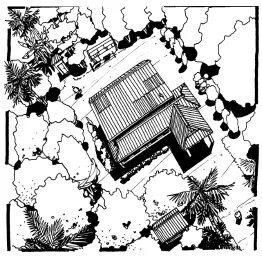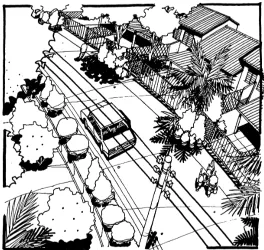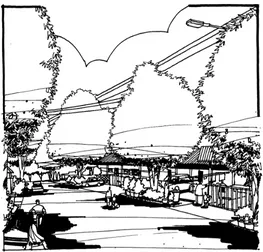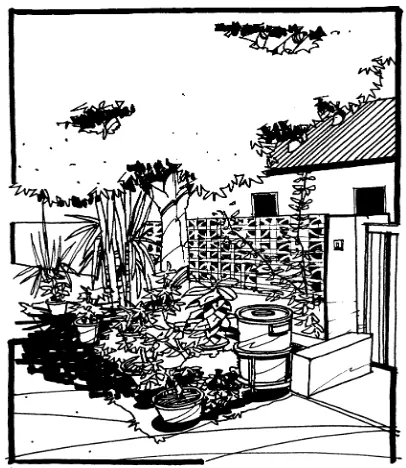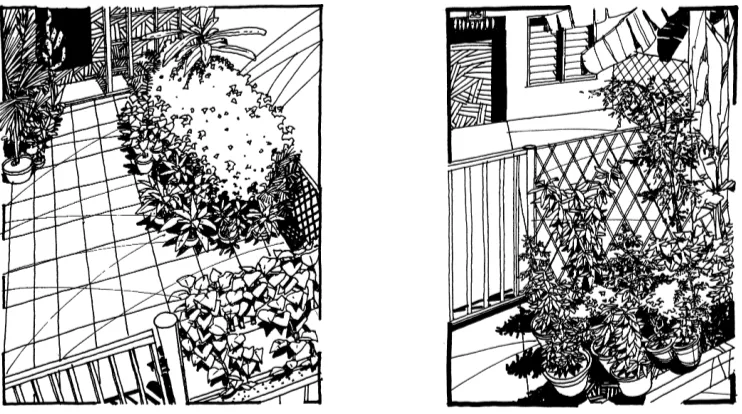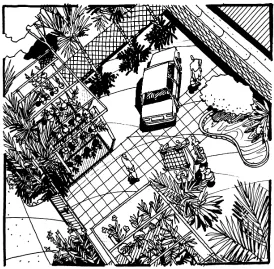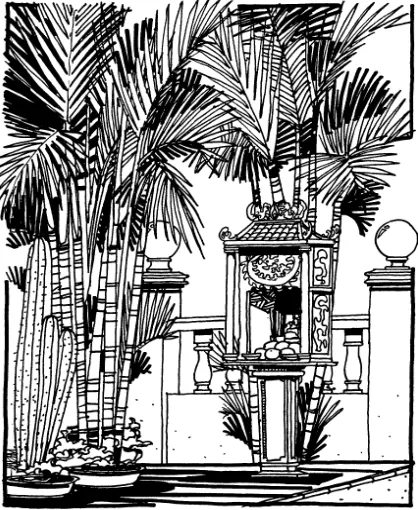Jurnal Teknologi, 35(B) Dis 2001: 41–53 © Universiti Teknologi Malaysia
PLURALISM IN TERRACE HOUSING COMMUNITY THROUGH ETHNIC GARDEN
ISMAIL SAID*
Abstract. Cultural-ethnic landscape symbolizes the belief and cultural values of an ethnic group living in a community. The landscape is an expression of people’s idea and work, illustrating intrinsic understanding and relationshi p of people to their fellow beings and environment. Such landscape is significant to the human community development and more challenging to establish it in a multi-ethnic society such as terrace house neighborhood in Peninsular Malaysia than in homogenous society. This paper discusses the role of ethnic gardens created by terrace housing residents towards integration and sense of belonging to their living neighborhood. The making of the residential gardens by Malays, Chinese and Indians are influenced by both cultural values and functional needs. There are few similarities and differences in planting composition, plant selection and garden accessories that reflect the strength of ethnicity and yet allow sharing of garden pro-duce and create a sense of place for the community. This pluralism can be seen as positive phenomena to harmonize multi-ethnic society living in terrace housing neighborhoods in Peninsu-lar Malaysia.
LORE OF ETHNIC GARDEN
Cultural landscape symbolizes the belief and cultural values of an ethnic people in a homogenous or heterogeneous society. It is an expression illustrating intrinsic un-derstanding and relationshi p of ethnic people towards their living environment. Rural settlements in Peninsular Malaysia such as villages of Malays and Chinese and plantation settlements of Indians possess some cultural landscape characteris-tics. The landscape is composed of architecture surrounded by plant species that are planted for purpose or values of decoration (embellishment), food, medicine and cosmetic, ritual and simply for provision of shade (Ismail Said, 2000). Our research,
Determining Cultural-Ethnic Landscape in Terrace Housing Community in Malaysia
(December, 2000), discovers that the hierarchy of plant species cultivated in village garden is as follows: 34 species for food, 23 species for medicine and cosmetic, and between 13 to 18 species for provision of shade, decoration and ritual. Generally, the layout of plant in the rural residential garden is integrated to the house; the compound is divided into frontyard, sideyard and kitchen garden (Figure 1). The size of these zones varies from one house to another that depends on the size of the house lot.
The Malays, Chinese and Indians utilized some similar plant species for provision of food and shade such as fruit trees, and decorative purpose particularly flowering shrubs. Mango, jambu air (Eugenia jambos) and rambutan trees are examples of fruit trees that are commonly seen in villages or plantation settlements of the three ethnic groups. Bright colored flowering shrubs such as bougainvilleas, ixoras and hibiscus are the favorite for all the races. But there are a few flowering and medicinal shrubs which differentiate the ethnic choice of plant selection. The selection of plant species is influenced by both cultural and religious values.
The Chinese garden is distinguished by red colored plant such as sealing-wax palm, bougainvillea, Euphorbia species, foutune plant (Adenium obesium) and poinsettia. The plants are believed to bring fortune to the household or shun evil from intruding into the house. One peculiar fruit tree that is often planted at the gate of the Chinese house is pomegranate, either planted on ground or in large clay pot. Several beliefs are attached to the plant including as symbol of fertility and as prom-ise of faithful offspring to the family. It is an important element in funeral ceremony that its leaves are soak in water and taken as bath after attending burial. This act will cast away bad spirits and stop them from entering the house.
The Indians also show strong relationship with plants cultivated in the house gardens. The common species which characterized their gardens include kacang
kelo (Moringa ptergosperma), Krishna thulsi (Ocimum santum), nochi, jasmine (Jasminum sambac) and susun kelapa (Ervatamia coronaria) that supply fruit for cooking, leaves and flowers for religious rites. Krishna thulsi commands the highest stature in the garden plant since it is sacred and its leaves are used as medicine. In a spacious garden, it is planted without association with other plant species and thus making it become specimen in the entire garden. Aromatic flowers of jasmine and ervatamia are the essentials for Hindu prayer. Their buds are tied to form malai (garland) which worn by ladies as hair accessories. Having the flowers in their gardens would make the Indians always ready for many auspicious festivals. Thus the establish-ment of gardens in their residences is essential and helpful for them to practice Hinduism.
Selection of plant species in the Malay garden is also determined by cultural values and ritual beliefs but relatively less conspicuous than the Indians and Chi-nese. Islam prohibits them from believing that tree possesses supernatural powers to protect man from evil or prevent from mishap or to become interceder for God mercy. Thus fruit trees and flowering and herbs would be commonly seen in the house garden supplying food and medicine while decorating the outdoor space of the house. Mango, rambutan, durian and Eugenia jambos are some of fruit trees with small to medium size canopies that signify the character of the village land-scape. Similarly to the Chinese and Indians, the Malays prefer colorful foliage and flowering shrubs to beautify their gardens. Thus one will often see hibiscus, codieum and ixora in the garden that are arranged in row forming hedges. Thus property boundary is defined by planting composition rather than fence or wall. Several species of herbs that are consumed as relish or medicine are planted especially in kitchen garden and side garden.
of residential neighborhood. The discussion is divided into three parts; (i) descrip-tion on the characteristic of ethnic gardens found in terrace housing; (ii) forms of pluralism that the ethnic gardens contribute to the terrace housing community; and (iii) place making created by garden accessories.
ETHNIC GARDENS IN TERRACE HOUSES
Residential communities in the towns are housed in mass housing. Most of the houses are built in rows linking to each other by party walls. They are built repeti-tively in similar forms and façade treatments creating a living environment with monotonous architecture. The mass housing scheme in towns and cities in Peninsu-lar Malaysia began in early 1970s, which resulted to high density living communities (18 to 24 units per acre) resulting to a living community often lacks in identifiable and personalization landscape.
Plant is the distinctive element that dominates the terrace-housing neighborhood in Peninsular Malaysia. Research done by the author found that 52% of the terrace houses of the multi-racial community has appropriate garden in the frontyard of the dwelling (Ismail Said, 2000). The residents utilized a total of 162 plant species of shade and fruit trees, flowering and foliage shrubs and a variety of herbs, climbers and groundcovers. In comparison, there are about 100 plant species in rural house compounds even though there are more space for gardening in the rural setting. Thus urban terrace house dwellers introduce many varieties of plant in small quan-tity. The establishment of the garden is more significant in those neighborhoods that have been resided for more than five years. Consequently, landscape in low-cost terrace neighborhood is more developed than medium-cost neighborhood, indicat-ing the resident commitment and attention to their gardens.
to potted planting, and sometimes encroach to the reserve space on the road shoul-der. The reserve space, about 1.5m in width and average size of 4.5m2, is the plant-ing zone for street plantplant-ing. Sometimes kitchen garden is included in the lot located at the back of the building. Here the residents put up the cloth line and plant some herbs. It is much smaller than the frontyard, about 1.5m in width. Within such constraint, many residents tried to establish gardens with ethnic characteristics, cre-ating a sense of place to the neighborhood. In the urban community, the potential on variations of cultural garden is high due to the multi-ethnic society living in the terrace houses.
End lot terrace house is blessed with large space for gardening. Generally, the garden size is more than 130m2, as big as the building floor area. Hence, residents have leverage to do more plantings including fruit trees such as mango (Mangifera
indica), jambu air (Eugenia aquea) and coconut (Cocos nucifera). The garden is
bor-dered by variety of flowering shrubs and herbs with lawn area as wide as 6.0m that become the play space for the residents. Generally, the lawn is composed of native grass species, cow grass (Axonopsus compressus), a hardy species that can survive for many years. Sometimes, residents preferred fine texture grass such as Zoysia species for better embellishment in the garden. Other than the plants, the residents intro-duced several garden accessories including fishpond with cascade or fountain, swing, altar, fence and wall, and shelter in the garden.
The local road in terrace housing neighborhood is characterized by medium to large size trees planted by local authority. The main purpose is provision of shade, thus only non-fruiting species are specified for street planting. Repetition of similar species along the road shoulders in many neighborhoods of a town resulted in similar outlook that lacks individual character and identity. Some dramatic changes in the landscape are coused when the residents remove the existing planting and replace with their own planting composition on the road shoulder. The residents would focus on planting fruit trees with herbs or foliage shrubs under them. The landscape can be recognized further through planting and garden accessory compo-sitions selected by the different ethnic communities to make their gardens.
FORMS OF PLURALISM BY PLANTING COMPOSITION
The ethnic garden contributed in place-making development, amelioration of mi-croclimate and social integration to the multi-racial terrace housing neighborhood. Accumulation of individual garden character and roadside planting along the resi-dential road contributes to the making of gardenesque landscape. Many residents extended their garden to the road shoulder. This spillover effect is being perceived positively as it signifies a sense of belonging by the residents toward their commu-nity. The effects of place making, microclimate amelioration and social integration are explained together in the following paragraphs.
as mangosteen and mentega (Diospyros discolor) can be used as children play equi p-ment. By building a tree house on the tree or a swing hanging from the tree branch would facilitate the children to make friends and cultivate the habit of sharing.
Figure 3 View of a local road shaded by mango trees at Taman Merlimau’s neighborhood
Occasionally, vegetable gardens are also cultivated on the road shoulder with varieties of species such as onion (Allium cepa), pineapple (Ananas comosus), okra (Hibiscus esculantus), yam (Caladium), maize ( Zea mays), pandan (Pandanus fragrans) and many other herbs. The attitude of encroaching onto the road shoulder may seem against the munici pality regulation. But the planting composition further adds the landscape variety of terrace housing neighborhood, differentiating one over another. Surplus vegetable could be easily given to the neighbors. Again, the attribute of sharing the garden produce can further strengthen the bond between residents in the community.
The physical character of the overspill garden would further characterize the ethnicity of the resident. The research has found that the Malays preferred herbs particularly lemon grass (Cymbopogon citratus), tumeric (Curcuma domestica), chillies
(Capsicum frutenscens), pandan (Pandanus odorata), basil (Ocimum basilicum), pegaga
(Hydrocotyle asiatica), and lengkuas (Alphinia galanga). But the Chinese would
plenti-ful. On the other hand, the Indians preferred to plant okra, eggplant, basil, turi
(Sesbania grandiflora) mixed with flowering shrubs, jasmine and ervatamia. The
differences in planting composition signified the atmosphere of ethnic personaliza-tion and preference that are directly influence by culture and belief. The landscape that emerges from this conglomeration is like a collage makes from variety of pic-ture. The variety in ethnic garden character creates a sense of unity in the housing community. It simultaneously develops a sense of place and belonging to their com-munity.
The scene in the terrace house frontyard garden of the three ethnic groups is composed of decorative plant including bright flowering shrubs including bougain-villea, hibiscus, ixoras, allamanda and rhizomes especially alphinias and heliconias. In addition, several multicolored foliage shrubs or herbs such as crotons and coleus are also introduced into the garden. The cultivation of flowering shrubs spilled over outside their house compound onto the road shoulder as shown in Figure 4.
Figure 4 Residents of terrace house normally used the road shoulder as an extension of their gardens
act of exchanging plant creates warm and coherence relationship among the resi-dents living in a multi-racial community. Thus a sense of unity can be accomplished in the neighborhood through the aesthetic value of plant species.
The Indian garden is conspicuous with the presence of white flowering shrubs especially jasmines and ervatamias (Figure 5). They are planted on the ground ei-ther in the house garden or on the road shoulder. They supply continuous amount of flowers for ritual offerings at temple and hair accessories worn by women. The demand for the flowers is very much felt during religious festivals including Ponggal, Mahashivatri and Thai pusam. Having the tree in their garden would make the Indian always prepare for the religious occasions. Two herbs species, khrisna thulasi (Ocimum sanctum) and nochi also characterize the Indian garden. Thulasi is tradi-tionally revered as synonym for beauty, purity and prosperity (Soundra, 1982). Devoted Hindus would always cultivate this plant in their gardens because it is intimately associated with religious worshi p and offerings.
Apart from the flowering shrubs and herbs, fruit trees also characterized the Indian terrace garden. The trees include mango, banana, neem, Sesbania
grandi-flora and Moringa pterogosperma that supply fruits as food and leaves for ritual and
religious purposes. The banana trees are planted for their fruits, either eaten fresh or as ingredient to make cakes. The leaves are used for wrapping food or even as platter serving rice and curry. The Indians regard the banana tree as a symbol of prosperity and fertility demonstrated by the numerous fruits in a bunch. It is com-mon practice that a pair of banana tree with fruits are cut and tied to the gateposts of the bridegroom house and a pair at the temple gate. The neem trees are planted on
the road shoulder to provide shade, their leaves are used as medicine for various diseases and as antiseptic to clean cut and wound. Fresh mango leaves are tied in string and attached to doorframe to cast away evil from entering the house. Indian gardens have specific planting composition that benefit them culturally, religiously, and aesthetically enhancing their terrace house environment.
PLACE MAKING THROUGH GARDEN ACCESSORIES
The Malays seems do not possess any distinctive garden accessories that make their gardens different from the Chinese and Indians. Since the Malays practice Islam, they are prohibited from believing physical items such as plant or altar for submis-sion to God. Some house gardens are facilitated with seat, either made from timber or concrete, placed under shade tree or palms. This space becomes a gathering node for the household and their neighbors. A simple swing made from a pair of rope and timber plank tied to a branch of the shade tree might be seen in a Malay garden. There are a few end-lot houses with vegetable gardens and chicken coops. The quality of rural lifestyle is brought into the urban neighborhood although chicken rearing may cause disturbance to the neighbors, some of the terrace house residents persist to raise the animal for food or hobby. Some would also raise birds in
tive cages hang from the porch’s rafters. This is a hobby that is also being shared by some Chinese.
The most conspicuous garden accessory in Chinese terrace housing community is the red altar, mostly placed on post or pedestal (Figure 6a and 6b). It is usually placed at the corner of the house garden in relation to Feng Shui principle. Buddhist priest determines the placement of altar. Since red is the color of the happiness and prosperity, some Chinese residents hanged red cloth and a mirror at the front door. The scene is more attractive and vivid during Chinese New Year celebration when residents hang golden lucky charms at the door. Chinese would differ from the Malays in the choice of garden accessories particularly plant containers. The Chinese residents prefer decorative clay pots, noticeably with dragon motif. Small fishponds with cascades and fountains are also common in the Chinese gardens signifying the values of water and fish in their beliefs.
The Indians would differentiate their garden by introducing colorful prayer motives especially the icon of elephant on the gate columns. Occasionally, Indian residents of terrace houses placed disposed clay or metal pots, with painted white spots, on fence posts to cast away evil spell. This ritual practice would also guard the residents from demons or ill feeling of people toward the residents.
CONCLUSIONS
It is important to recognize and understand the role of cultural-ethnic garden toward physical and social character development of terrace housing community in Penin-sular Malaysia. The research shows that the Malays, Chinese and Indians are prac-ticing the value of making cultural landscape in their neighborhood. Individual gardens and roadside planting on local roads form the cultural landscape. The garden and its planting symbolize the will and effort of the terrace house residents to create their own living space. It is an expression of the household to partici pate in the development of a community. Its character signifies the ethnicity of the resident. Resident of a terrace house would be proud to proclaim that the garden is deve-loped through his idea and belief. Furthermore, the cultural garden and architecture form a living community that ultimately creates a sense of belonging or spirit of place for the three ethnic groups to live and interact. This intangible product is necessary to be held by each individual living in a heterogeneous society. Residents are free to practice their belief through the making of the garden. This freedom is a prerequisite factor to promote and maintain harmony in the multi-ethnic commu-nity. Although most gardens are self-designed and constructed, the selection and arrangement of plant species and placement of landscape features conform to cul-tural and religious values. Gradually the character of the garden changes as the plants grow bigger or the owner modifies the design. However, the princi ple in selection of plant species for the garden remains the same.
After knowing the existence of cultural landscape in terrace house community it is essential for landscape architects, urban planners and architects to consider these landscape values in the planning and design of urban residential areas. Local authorities should integrate the cultural landscape values during zoning and preplanning of residential estate. They should make the planners and designers aware that establishment of cultural landscape is a positive mode to integrate people in a multi-ethnic community. It must be noted that community development is not only through planning and layout of buildings and utilities but it is also to be accom-plished through the sense of pride and belonging of every resident to their commu-nity.
ACKNOWLEDGEMENT
The author would like to thank Research Management Centre of Universiti Teknologi Malaysia for funding of the above studies.
REFERENCES
1. Burkill, I. H. 1930. Malay Village Medicine. Garden’s Bulletin Straits Settlements, Volume 6, p: 264-268. 2. Cheu, Hock Tong. 1993. Chinese Beliefs and Practices in Southeast Asia: Studies on the Chinese Religion in
3. Ismail Said. 2000 Determining Cultural-ethnic Landscape in Terrace Housing Community in Peninsular Malaysia. Research Management Center Vot 71536 Universiti Teknologi Malaysia, unpublished. 4. Low, Albert. 1995. Practical Feng Shui for the Home. Pelanduk Publications.
5. Mong, Lee Siow. 1986. Spectrum of Chinese Culture. Pelanduk Publications.
6. Ong, Hean-Tatt Chinese Plant Symbolisms. 1999. A Guide To The Symbolic Value of Plants in Chinese Culture. Pelanduk Publications, Selangor.
7. Rapoport, A. 1977. Human Aspects of Urban form. Oxford: Pergamon Press. 8. Wei, Tsuei. 1992. Roots of Chinese Culture and Medicine. Pelanduk Publications.
9. Winstedt, Richard and Che Seong Tham. 1981, The Malays: A Cultural History. Gham Brash Publishers. 10. Yuan, Lim Jee. 1987. Rediscovery Malaysia’s Indigenous Shelter Garden. Institut Masyarakat
ABSTRACT
